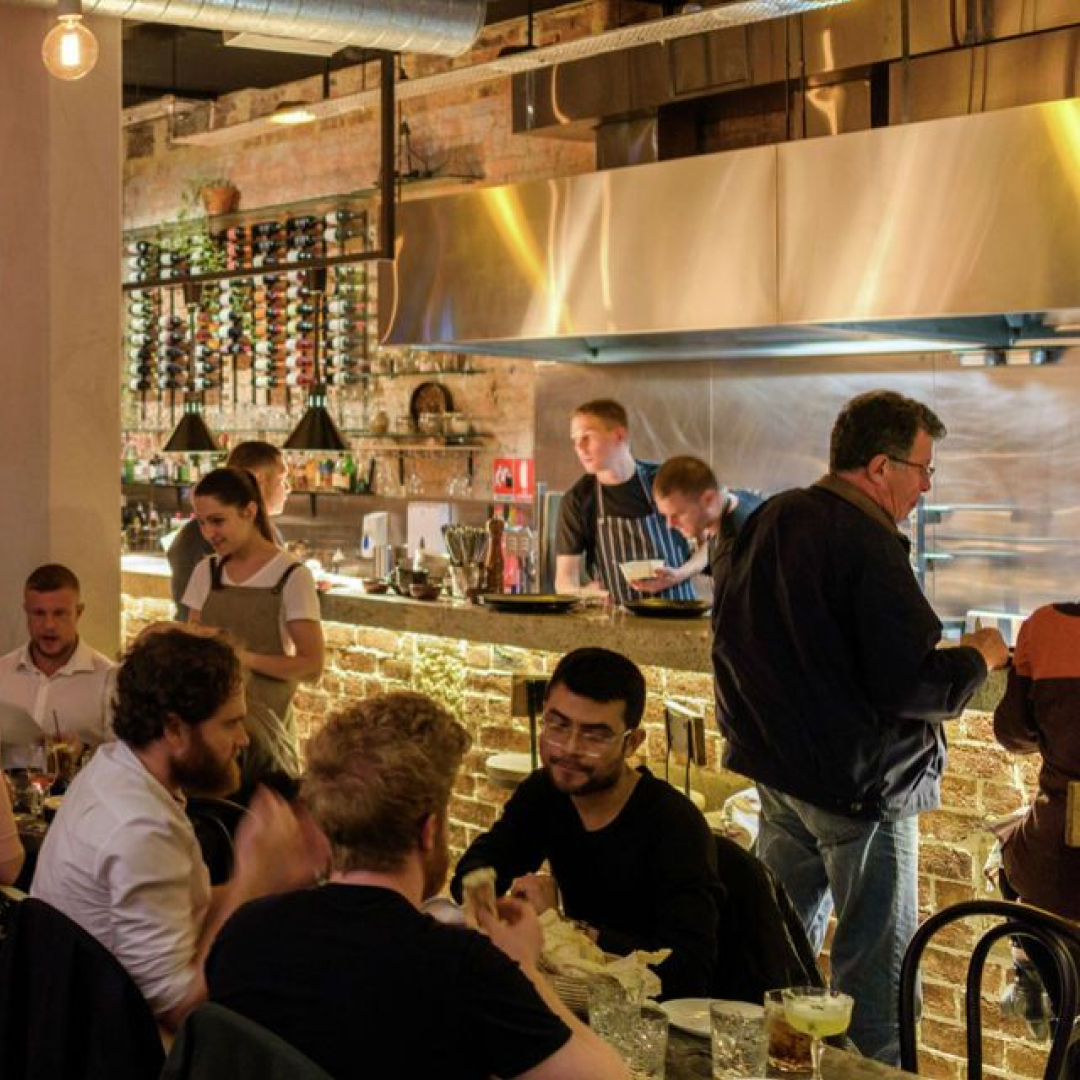The information provided in this article does not, and is not intended to, constitute legal or financial advice; instead, all content is for general informational purposes only. Information in this article is presented “as-is” and may not constitute the most up-to-date information. All liability with respect to actions taken or not taken based on the contents of this article is hereby expressly disclaimed.
Most restaurants need funding, especially during the initial stages when they’re setting up. But finding the right investment is easier said than done and requires careful planning as well as excellent execution.
The purpose of this guide is to help you with all the ins and outs of funding a restaurant with top tips from those who have been there, seen it, and done it.
Quick links
Chapter 1: Business structure
- Ownership
- What to expect from the fundraising process
- Friends, family and you
- What makes your restaurant a good investment?
- What makes someone a good Investor?
- Investor relations
Chapter 1: Business structure
The right business structure
As an aspiring restaurant owner, you’ll need to figure out the structure and how it relates to getting the right type of funding. This stage can be overwhelming and confusing, so don’t try to figure it out yourself. Get an attorney involved to help you sort through the pros and cons of each structure, as there is no one way that works best when it comes to financing a restaurant.
A business structure addresses several aspects of your restaurant:
- The amount of taxes you will pay
- The extent to which you and your partners/investors are held personally responsible for debt incurred by your restaurant (liability)
- The amount of flexibility you have in the event you decide to sell or transfer the business
- How investors get paid back
- The protection of your intellectual property
The best way to find a great attorney is to ask peers whom you trust and respect for referrals. Whoever you hire must have extensive experience in working with the specific type of restaurant you’re planning to open.
For example, an attorney who has 50 restaurant clients that are all fast-food chains can rightly claim that they have a lot of restaurant experience, but if you’re planning to open something closer to The French Laundry, this is not a good fit.
“You don’t have to retain a lawyer up front, but you at least need to have a consultation with an attorney to understand your options in terms of incorporation, as well as the laundry list of other things that you’ll need to consider. Then, when you get to the point when you’re ready to retain an attorney, you already have someone that’s familiar with you and your concept,” Roberta Economidis, Founding Partner at GE Law Group.
Overview of a common business structure
There is no blanket “best” or “worst” way of structuring your business. You and your attorney will work together to determine the most successful structure based on your specific wants, needs, and circumstances. Below is a brief overview of each major category.
Sole Proprietorship
A sole proprietorship is simple — it means you are the only owner of your business. You own all of the property, you keep all of the business profits, and you are also personally liable for its debts.
Partnerships
There are two different types of partnerships, general and limited.
General Partnership
This works just like a sole proprietorship, but with multiple people. General partners, like sole proprietors, bear the risk of unlimited personal liability.
Limited Partnership
In a limited partnership, there must be at least one general partner and the rest of the partners can be limited partners.
Two things to know here:
- If someone is a limited partner, they cannot be an active part of running the restaurant operation and they do not bear personal responsibility for the debts of the business beyond the amount of money they invested.
- They do not bear personal responsibility for the debts of the business beyond the amount of money they invested.
Corporations
Corporations are created by state law and essentially separate you and your partners or investors from your business. If your restaurant is a corporation and it fails, everyone who is invested in it (yourself included) is only responsible for his or her own investment, nothing more. People create corporations to shield themselves from liability.
There are two types of corporations: S Corps and C Corps. They each have pros and cons that your lawyer and accountant will be able to explain to you in the context of your specific business.
Limited Liability Companies
An LLC has shared attributes of a combination of a partnership and a corporation. There are some distinct advantages to creating an LLC: all members (including you) are sheltered from liability; depending on the structure, either you have all of the authority, or all members have the right to help manage the business, and there is no limit to how many shareholders you can have in an LLC. Another big plus is that LLCs are very flexible, and this flexibility will be helpful when it comes time to structure investment payback terms.
S Corp Within An LLC
Roberta, Partner in the law firm of Georgopoulos & Economidis, LLP, provided great insight into the option of creating an S Corp that will act as the manager of the LLC for two important purposes: first, to improve the restaurateur’s tax treatment and secondly, to ensure that the restaurateur’s intellectual property is protected.
If you’re thinking about replicating your concept — building more stores of the same concept or opening multiple concepts — it can be beneficial for the restaurateur to be a member of an S Corp, not the restaurant’s LLC. The S Corp is generally 100% owned by the restaurateur, which means that the restaurateur also owns 100% of the intellectual property.
The S Corp will be the entity that goes on to open up other LLCs and other restaurants, effectively protecting the rights to a restaurateur’s concepts and ideas, since the investors will only be owners in the subsidiary LLCs.
Chapter 2: The financials

How much will you need?
The question every aspiring restaurateur of course wants to know is, “So, how much is this whole thing going to cost?” The short answer is, it varies wildly depending on your market, concept, space, and a host of other considerations.
Those considerations are a great place to start when putting together your capital requirements budget, which we discussed in Chapter 1. That capital requirements budget should include a summary of all of your opening costs, including working capital and contingency money for when (not if) you exceed your initial budget.
Your pro forma and your capital requirements budget will help determine how much working capital you need based on when your restaurant is projected to generate positive cash flow.
This list includes some but not all of the items to consider when putting together your capital requirements budget:
- Rent & rent security deposit
- Design costs
- Architect
- Designer
- Contractor
- Construction costs
- Contractor
- Legal fees
- Accounting fees
- Other consulting fees
- Licenses & permits
- Liquor license
- (More information on licenses and permits in Chapter 4)
- Insurance
- Furniture, fixtures, and equipment
- Kitchen equipment
- Front-of-house smallwares
- Back-of-house smallwares
- Dining room furniture
- Point-of-sale system
- Reservation system
- China, glassware, silverware, holloware
- Opening inventory of all food & beverage
- Opening payroll, including staff training (discussed in Chapter 9)
- Pre-opening events (discussed in Chapter 9)
- PR & marketing
- Working capital
- Contingency
Once you, your attorney, and your accountant feel comfortable with the accuracy of each estimate in your capital requirements budget, you’ll have your fundraising goal. As a best practice, err on the side of overestimating your expenses.
Structuring investor payback and ownership
Once you’ve figured out how much money you need to raise, you’re ready to hit the pavement and start pitching investors, right? Not quite. Before approaching potential investors, you need to have a good idea of what you plan to offer them. Work with your attorney and accountant to figure out what payback terms are best for your particular business, as well as how your ownership structure will break down. Don’t be afraid to ask questions when solidifying these details. The more confident you are navigating the terms of your restaurant, the more confident potential investors will be in your handle of the project.
Take the time to research what investors in your market typically like to see in deals. Roberta’s golden rule? “Know thy investor. Having a good idea of what your investor wants is the key to getting them on board.”
Mike, Co-Founder and Senior Partner at venture capital firm ARTIS Ventures, says, “Investors are looking for good quality payback terms. In the Bay Area, that tends to mean a 60/40 split in favor of the restaurant if it’s your first time, and closer to 70/30 if you’re proven.
Investors here like to reap anywhere from 90 to 100% of profits until their investment has been paid back 125%.” But remember, those numbers vary depending on the market, economic conditions, and the particulars of your business.
Payback terms
Regardless of how your payback terms are defined, there are general rules of thumb for how long it should take you to pay your investors back. You want to be able to pay your investors back plus their return somewhere within two to four years. If you’re in fine dining, where the profit margins are not as good as casual concepts, you want to pay your investors back plus their return within five years. Anything above these benchmarks, and you should revisit your financial projections and perhaps tweak your concept.
Preferred returns
A restaurant is generally regarded as a risky investment — even more so when it’s a new, unproven concept and a first-time restaurant owner. A preferred return prioritizes and expedites the investor payback process by using 90 to 100% of your restaurant’s profits in the first few years of operation to pay back their full investment, plus whatever interest rate or premium is defined in your payback terms. Once they’ve been paid back plus their preferred return, the restaurant’s profits will revert to being divided based on your ownership structure.
- You own 70% of the business and your investors own 30%
- You have agreed to pay your investors back their initial investment plus 25%
- You have agreed to pay investors 90% of the restaurant’s profit until the preferred return is reached
- Your investors contributed a total of $500,000
- Your restaurant is earning approximately $200,000 per year in profit
In this scenario, you will be paying your investors 90% of your $200,000 profit ($180,000) until you’ve paid out $500,000 + 25% ($625,000). So, in this scenario it would take about 3.5 years to pay your investors back and once this is done, the division of profit would revert to the 70/30 ownership structure you set up for the life of that business.
In addition to prioritizing investors, Charles, owner of Souvla in San Francisco, says, “You’re also incentivizing yourself as the operator to run as lean, mean, and profitable of a business as humanly possible, because your motivation is to close that preferred return period and revert to whatever equity split that you have set up for the business so that you, the owner, can start actually making money.”
Chapter 3: Fundraising

Ownership
Before you get to the fundraising part, you’ll need to decide on ownership. How you structure ownership for your first restaurant will be a careful balancing act between making the opportunity attractive to investors and ensuring the terms are fair for you. Expect investors to own a larger portion of the business than they will once you’ve opened a couple of successful places and proven that you’re able to run a profitable business.
With that said, you will never want to own less than 51% of your business so that you always have control of it. Roberta agrees that being good to your investors, especially when it’s your first restaurant, is extremely important. But she encourages restaurateurs to think past the immediate future when structuring ownership so that if the business grows and other key team members emerge, the equity structure allows for some flexibility to offer team members equity or profit sharing.
Offering investors great terms through a preferred return gives them an attractive option to not only protect their investment, but to earn something above and beyond what they originally put in.
Once you have a solid understanding of what you’d like to offer investors, Roberta recommends putting together a term sheet with your attorney and accountant and floating it past the core group of investors that you know are dedicated to supporting your project.
This lets you take the temperature of your most committed investors, and if they don’t like the terms that are being offered, you can easily adjust your term sheet. If you skip this step and go straight to submitting your offer to investors through a private placement memorandum, you may end up wasting a lot of time and money if changing the terms is necessary.
What to expect from the fundraising process
Raising money will be a process with each person you approach. Nearly no one will be willing to give you money after just one meeting, so think about the process as building a relationship, not as a transaction.
In more than one conversation with restaurateurs and investors, the process was likened to dating. Get to know each other. Take the time to figure out if your areas of expertise complement one another, if your passions align, and if your personalities click. They don’t need to be your best friend, but it also doesn’t make sense to do business with someone you don’t trust. When appropriate, try dining in a restaurant with a potential investor and using the backdrop as an opportunity to discuss and evaluate your concept and establish some common ground.
Pitch meetings
A pitch meeting is exactly what it sounds like — the first time you meet with a potential investor or speak to them over the phone is your opportunity to present your concept and get them excited about it. Some people will request a copy of your business plan in advance of the meeting (yes, you should send it to them), and if not, bring them a copy to keep. This is also where the pitch deck we discussed in Chapter 1 will come in handy. Be ready to explain who you are, how you came to this idea, and most importantly, why the market needs your restaurant.
Mike says, “The first five to 10 minutes are crucial, especially for people that get pitched all the time. In that first meeting, just focus on getting them excited. Don’t focus on too many details, just present the core of what you’re doing and if it meshes with that person and they’re excited about it then you’ll earn yourself another meeting.”
If the relationship doesn’t quite click in this first meeting, don’t throw away their email address. Keep them on your list and invite them to any events you host on behalf of your future restaurant (explained below). You never know if and when a restaurateur/entrepreneur will intersect with someone they’ve met before in the industry.
Site visits
If you have a location secured while you’re in the pitching process, invite potential investors to meet you at your site. The more you can incorporate tangible, visual elements into your presentation to help the potential investor better understand what you’re planning to build, the better.
However, you will also need to be prepared to hold pitch meetings before you’ve secured a location because signing a lease not only requires a good chunk of capital, it also requires confidence that you’ll be able to find the rest of the funding you need to get the restaurant up and running (see Chapter 3 for lease-negotiating tips on this topic).
Charles says that this was one of the most challenging aspects of the fundraising process for him. Almost everyone that was interested in his concept would immediately ask where the restaurant was going to be. Despite having a well-researched list of neighborhoods ready to go, the response he got to that was mostly, “Let me know when you have a location.” This can turn into a real chicken-and-egg situation, especially in cities like San Francisco, where finding and securing the right site for your restaurant can take years.”
If investors commit to you before you’ve found a location, be sure to meet with them again on site so they have an opportunity to get a status update on the project, familiarize themselves with the site, ask questions, and get excited about the progress you’ve made.
Events
Host an event where you bring everyone who’s interested together for a tasting dinner or something that represents your specific concept, so people can really envision it. When? It depends. These events are a great way of getting investors that are on the fence off of it, but they also come at a financial cost, so be mindful of making sure the money you’re investing in events has a tangible payoff.
Friends, family and you
Before approaching anyone about investing money in your restaurant, figure out how much you’ll personally be able to contribute. Even if it’s nowhere near the six-figure range, any outside investor will want to see that you’ve got some skin in the game.
After you’ve assessed how much you’ll be able to chip into the pot, your friends and family will likely be the next group of people you speak to about investing money. For the sake of your business and your personal relationships, be pragmatic and professional in your approach. Treat each individual in this group just as you would any other potential investor because regardless of your personal ties, you’re asking them to give you real money, and to take a real risk on your business. Both parties need to be emotionally and financially prepared in the event that the business fails; if the idea of not being able to pay them back is too tough to bear, it’s probably best that you pass.
Even if you’ve told your older brother about the restaurant of your dreams for the past 20 years, don’t waste a valuable opportunity to practice your pitch and answer questions. It will take you time to get comfortable with the process of presenting your idea to new people, so use your friends and family to help you build confidence.
What makes your restaurant a good investment?
First of all, an investor wants to know that the financial terms (ownership structure and payback terms) are reasonable. Next, they will assess the financial feasibility of your concept and whether it’s something they’re interested in or passionate about. Mike says, “Of course, the investor needs to know that you have a good business model that’s based on conservative projections and not a best-case scenario, but once that’s established, they’re looking at the vision, the concept, and the passion behind it.”
Matt Hemsley, one of the primary investors in Spoon and Stable in Minneapolis, stresses:
“Even if you know that the economics are sound, they are never going to be the compelling part of the deal. Ever. If you’re looking at high-net worth folks who are sophisticated investors and you say ‘please invest in this hugely risky operation with low financial returns for the sake of making money,’ they’ll look at you cross-eyed. For that reason, finding investors whose passions align with yours is really important.”
The moral of the story is, if you’ve done your due diligence up to this point — if you’ve written a researched business plan, built conservative financial projections, created investor-focused payback terms and a fair ownership structure — you should be able to walk into these meetings with confidence, tell your story, and make an emotional connection with the investor. Ultimately, how passionate that investor is about the core of what you’re doing will determine their willingness to invest.
What makes someone a good Investor?
Finding investors is a two-way street — it’s a relationship, not a transaction. As a restaurateur, you want to find investors who compliment you and add value to your business outside of just providing capital. Don’t sign on investors if you don’t value their opinion in some capacity. Look for investors with experience in the restaurant industry or in areas that would be beneficial to a restaurateur.
Also, do your homework. Matt says, “Really get to know and try to understand from a third-party perspective who you’re doing business with. People build reputations over time and it’s not that hard to figure out if this is someone whose previous business partners would all do business with him or her again or if it’s someone that’s burned every bridge that they’ve crossed.”
How to find investors
Well folks, if you were hoping for a consolidated list of phone numbers in this section, we’re sorry to disappoint. There is no silver bullet when it comes to finding investors (or anything else, really).
Mike says, “You can sign up for every list and buy all the things and do all the stuff and go down every rabbit hole, but it just never works. I’ve just seen people try everything and the truth is, there isn’t any other way outside of just hustling and picking up the phone and calling every single person you know and just be out there living it and breathing it and doing it.”
For Charles, outside of friends and family, all of his investors came from networking. The group of people that ended up funding his business wasn’t what he initially expected it to be, but those people referred him to other people and that process, repeated many times, landed him with the capital he needed to start Souvla. Be persistent and patient, and as Mike warns, be honest with yourself. If you’re having a really hard time finding your first $200k, you’re probably just not quite ready yet.
There is no specific ideal number of investors. The key is setting a minimum amount for investment and then sticking to that; you want to avoid having a lot of people coming in at very small levels.
Investor relations
Many restaurateurs have found themselves in difficult situations as a result of not being clear about the benefits of being an investor before any contracts are signed. The contract and other investment documents that your attorney crafts for your investors will include information and parameters around what each party can and cannot do and how decisions relating to the business will be made, but some of the perks that your investors may be interested in aren’t appropriate for inclusion in legal documents.
With that said, it doesn’t mean that they shouldn’t be discussed. If an investor calls for a reservation for 10 people on Friday night at 8 p.m., how will you respond? Whether it’s yes or no, your investors should know in advance what special treatment they can expect. This conversation should be a positive one — this is an opportunity for you to get to know your investors and figure out what you can do to make them feel appreciated without compromising your operation.
Some restaurants have special beer steins with their investors’ names on them, or they host investor dinners a couple times a year. Roberta urges restaurateurs to do their research around investor perks because some of them, like meal credits, can be taxable to the investor and will incur an additional cost for the restaurant. Regardless of what you offer, make sure everyone is on the same page so that no one feels unsatisfied or taken advantage of down the line.
The key to healthy investor relations is managing expectations and creating a consistent flow of information regarding the state of your restaurant. A regular cadence of updates — from a quarterly investor meeting to a monthly email update — goes a long way to facilitate a strong
relationship where investors feel in the loop. You may have to answer some uncomfortable questions (particularly when numbers are behind schedule), but there is no substitute for having a productive dialogue with the folks who are financing your project.
Besides finding investors, there are other financing options to consider:
Bank Loans
Banks are the most conservative lending option you have, and given the risky nature of startup businesses, and restaurants in particular, don’t count on getting any money from them. Even if you personally guarantee the loan, most banks won’t lend you money.
Small Business Administration (SBA) Loans
The Small Business Administration is a government entity that works with designated lenders, like banks, to issue loans. Because the SBA will guarantee the majority of your loan (you must personally guarantee the rest), it’s more attractive to banks and other lenders to issue a loan. There are pros and cons of borrowing money through the SBA, and your accountant and attorney will be able to tell you much more about your options and whether it’s a viable source of funding for you. Restaurant Success By The Numbers, by Roger Fields, also has a comprehensive chapter on the subject.
Crowdfunding
Crowdfunding allows entrepreneurs to pitch their ideas to anyone and everyone via online platforms like Kickstarter and Indiegogo. People who are attracted to your idea enough to support it financially will pledge money in exchange for prizes and rewards. It sounds simple, but a successful crowdfunding campaign requires an average of 140 hours over the course of three to four months to adequately prepare for, as well as solid expertise in messaging, graphic design, photography, and videography. Given the few parameters that do apply to crowdfunding — namely, that you only get to keep the money if you reach your goal within the time limit applied to every campaign — you shouldn’t be relying on this method alone to finance your restaurant.
Desi Danganan of Plinth Agency is a rare expert on this subject. He is a successful entrepreneur who spent 10+ years as a restaurant owner and has raised over $2.65 million dollars for businesses through crowdfunding, angel investors, and VCs.
“Really smart restaurateurs aren’t using crowdfunding as the core of their financing. They’re using it for marketing that makes a little bit of money.”
Another major benefit? Crowdfunding is a valuable data point to show potential investors that there’s substantial interest in what you’re doing.
Here are some of Desi’s tips to ensure that your crowdfunding campaign is a successful one.
- Build a team of people with different skill sets. You’ll need a strong writer with a good sense of marketing messaging, a graphic designer, a skilled photographer experienced in food photography, and a videographer. Know what you don’t know.
- Set an appropriate goal. First, figure out what specifically you’re going to use the money for. Next, do research to figure out the average campaign amount in your market. Finally, calculate the cost of your rewards and factor that into your goal.
- Prepare. Research similar projects to understand what the average person contributed to other campaigns, and get all of your messaging and social media posts organized and planned out before your campaign kicks off. Once it starts, it’s a 30-day sprint and every day is critical.
- Build your audience early. “Momentum is essential in crowdfunding,” says Desi. “If you reach 20% of your goal in the first few days, you are 80% more likely to hit your goal. A successful party right after your launch can help jump-start your campaign by turning attendees into your evangelists.”
- Put thought into your rewards. You can’t make a branded T-shirt the reward for a $100 pledge; it’s too far from what someone would realistically pay for a T-shirt. Remember that this is more about marketing than fundraising. Feature prizes at a variety of price points to encourage as many people as possible to contribute. Every dollar counts.
- Track your results. Use Google Analytics and social media statistics to track key metrics like how many people are visiting your page, where they’re coming from, and how much they’re pledging. If your campaign isn’t performing as planned, be ready to change courses. “It’s like fishing. If people aren’t interested in the bait you’re using, change it.”
Conclusion: Key takeaways
- Raise more money than you think you need.
- Undercapitalization is one of the biggest reasons restaurants fail.
- Work closely with your advisory team — your accountant and your attorney — to determine how to structure your business, how to structure ownership, and what payback terms you should offer investors.
- Put your friends and family who are planning to invest through the same process as any other investor. It’s in your best interest personally and professionally to formalize the agreement.
- Don’t take money from anyone who will give it to you.
- This is a long-term commitment, so it needs to be a good fit for both parties. Taking on investors you don’t trust or value won’t serve you in the long run.
- Make a plan right out of the gate for how you’ll communicate with investors about the status and health of your restaurant once it opens.




